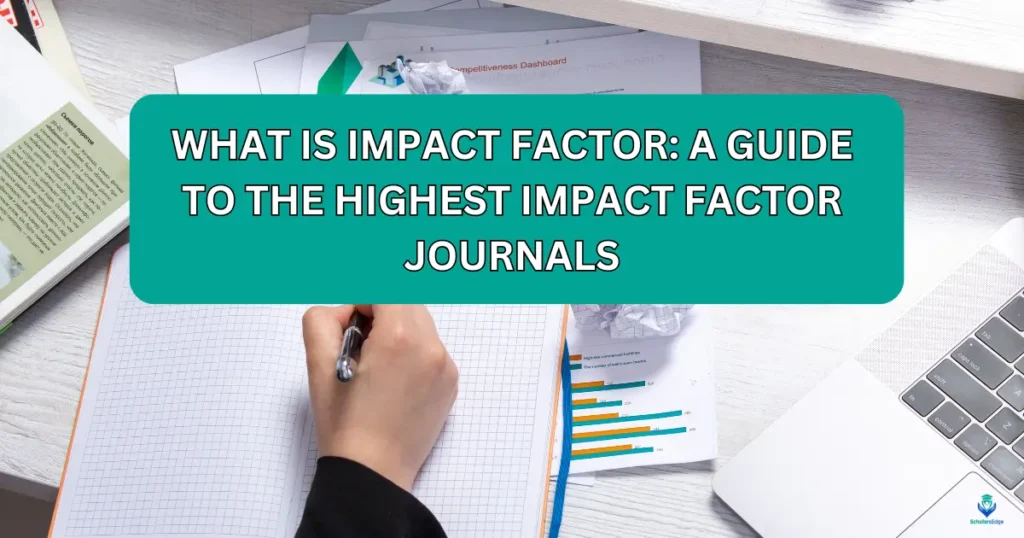
1. Introduction
In academic publishing, the journal impact factor, such as for Scopus-indexed journals, plays a crucial role in measuring the quality and influence of research. Researchers, authors, and institutions often rely on impact factor metrics to evaluate the significance of journals within a specific field. A high-impact factor can boost the reputation of a journal, making it more desirable for researchers looking to publish their work. For authors, publishing a paper in a high-impact journal increases visibility and leads to more citations, career advancement, and funding opportunities.
This article will explain what an impact factor is, how it’s calculated, what qualifies as a “good” impact factor, and which journals hold the highest impact factors across different fields. By the end, readers will better understand the significance of impact factors and how to locate high-impact journals for their research.
2. What is the Impact Factor?
The impact factor is a numerical value assigned to academic journals based on the frequency with which their articles are cited over a specific period, typically two or five years. It serves as a proxy for a journal’s relative importance within its discipline. The higher the impact factor, the more frequently the journal’s articles are cited by other researchers, indicating greater influence in the academic community.
The impact factor is calculated by dividing the number of citations in a given year by the journal’s total number of articles published in the previous two years. For example, if a journal published 100 articles in 2022 and those articles received 300 citations in 2023, the journal’s impact factor for 2023 would be 3.0. This metric is widely used because it provides a standardized method to compare journals across disciplines, making it a vital tool for researchers when selecting where to submit their work.
3. What is a Good Impact Factor for a Journal?
A “good” impact factor can vary widely depending on the field of study. In general, impact factors are higher in fields where research is rapidly evolving, such as medicine, biology, and engineering, compared to disciplines like the humanities, where research output and citations occur slower.
In many scientific disciplines, an impact factor of 10 or higher is considered excellent. In the social sciences, where citation patterns differ, an impact factor of 3 to 5 might be considered strong. Humanities journals typically have even lower impact factors, with a score of 1 or 2 considered respectable. It’s important to understand that a journal’s impact factor should be interpreted in the context of its specific field. What may be considered an impressive impact factor in one discipline could be considered average or below average in another.
4. How the Impact Factor of Journals is Determined
The impact factor is determined and published annually by Journal Citation Reports (JCR), a product of Clarivate Analytics. JCR tracks citation data from thousands of journals worldwide and provides an authoritative assessment of journal influence. It compiles impact factor scores by analyzing citations from indexed articles in Web of Science, a highly respected database of peer-reviewed journals.
To calculate the impact factor, JCR divides the total number of citations per year by the number of citable articles published during the preceding two years. For example, if a journal received 500 citations in 2022 for articles published in 2020 and 2021 and published 250 articles during that period, the impact factor for 2022 would be 2.0. Several factors influence a journal’s impact factor, including its reputation, the quality of its peer review process, and how often its articles are cited in major research studies.
5. Highest Impact Factor Journals: An Overview
Some journals consistently rank at the top of their fields due to their high impact factors. These journals are considered prestigious and are known for publishing cutting-edge research. Below are examples of journals with the highest impact factors in various fields:
- Medicine: The New England Journal of Medicine (Impact Factor: 176.079)
- Science: Nature (Impact Factor: 69.504)
- Engineering: IEEE Transactions on Pattern Analysis and Machine Intelligence (Impact Factor: 24.314)
- Social Sciences: Annual Review of Psychology (Impact Factor: 27.272)
These journals have achieved high impact factors due to their rigorous peer review processes and the significant influence their published research has had on advancing scientific knowledge. While these journals lead their respective fields, they are not alone in their high impact; many other journals also maintain impressive citation records, making them equally valuable for publishing high-quality research.
6. Why Journals with the Highest Impact Factors are Important
Publishing in high-impact journals offers several key benefits to researchers. First, it increases the visibility and accessibility of their work, as academics, practitioners, and policymakers widely read these journals. High-impact journals also tend to attract more citations, further amplifying the influence of the published research. In addition, authors who publish in high-impact journals often enhance their academic reputation, which can lead to more opportunities for collaboration, funding, and career advancement.
Journals with high-impact factors play a critical role in advancing scientific discovery. They are often seen as leaders in their respective fields and set the standards for quality research. Publishing in these journals reflects the significance of a study and contributes to the broader body of knowledge within a discipline, facilitating innovation and practical applications.
7. How to Find the Impact Factor of a Journal
Researchers can use several resources to find the impact factor of a specific journal. The most widely used tool is the Journal Citation Reports (JCR), which offers access to journal rankings, impact factors, and other metrics. Researchers can search for journals by name or subject area, making comparing journals within a specific field easy.
Here’s a step-by-step guide on how to find a journal’s impact factor:
- Visit the Journal Citation Reports website.
- Search for the journal by title or subject category.
- Locate the impact factor displayed next to the journal’s name and other metrics such as total citations and five-year impact factor.
- If JCR is unavailable, researchers can also check the journal’s homepage, as most publishers display the impact factor prominently.
Other databases, such as Scopus and Google Scholar, can also provide information on journal impact factors, though these may not be as comprehensive as JCR.
8. Is Impact Factor the Only Metric for Journal Quality?
While the impact factor is valuable, it is not the only measure of a journal’s quality. Several other metrics can provide additional insights into a journal’s influence and relevance, including:
- h-index: Measures a journal’s publications’ productivity and citation impact.
- Eigenfactor: Accounts for the quality of citations by weighting those from highly influential journals more heavily.
- SCImago Journal Rank (SJR): Similar to the impact factor but adjusted for the citation behavior in different fields.
These alternative metrics can offer a more comprehensive view of a journal’s reach and impact, especially in fields where citation patterns vary. Researchers are encouraged to consider various factors, including peer review quality, journal relevance to their topic, and audience reach when selecting a journal for publication.
9. List of Journals and Their Impact Factors
Here are some examples of journals and their impact factors across various fields:
- Medicine: Lancet (79.321)
- Biology: Cell (66.850)
- Physics: Reviews of Modern Physics (55.575)
- Environmental Science: Nature Climate Change (33.880)
- Psychology: Psychological Bulletin (22.750)
These journals are top-tier in their respective fields and are known for publishing groundbreaking research. While the numbers vary significantly across disciplines, they all share a reputation for excellence and influence in the academic community.
10. Conclusion
Journal impact factors are an essential tool for evaluating the quality and influence of academic publications. While a high impact factor can signal a journal’s prestige and relevance, researchers must consider other factors, such as relevance to their research and the journal’s peer review process. By understanding how impact factors are calculated and where to find them, researchers can make informed decisions about where to publish their work. Ultimately, the impact factor should be one consideration among many when choosing a journal, but it remains a crucial metric in academic publishing.
FAQs About Impact Factor Journal
How to find the impact factor of journals
To find the impact factor of a journal, you can use various tools and databases that provide this information, such as the Journal Citation Reports (JCR) from Clarivate Analytics. Start by searching for the journal’s title or ISSN within these platforms. Some publishers also display the impact factor directly on their journal websites. Additionally, you can visit research databases like Scopus or Web of Science, which list impact factors for many indexed journals. Verifying that you’re using the latest data is essential, as impact factors are updated annually.
What is a good impact factor for a scientific journal?
A “good” impact factor for a scientific journal depends on the specific field, as different disciplines have varying citation norms. Generally, a journal with an impact factor above three significantly influences most scientific fields. However, top journals often have impact factors well above 10 in highly competitive areas such as biology or chemistry. Remember that while a higher impact factor indicates more frequent citations, it doesn’t necessarily reflect the overall quality or relevance of the research.
What is a good impact factor for a medical journal?
A good impact factor for medical journals is typically higher than in many other scientific disciplines due to the large volume of medical research published each year. A journal with an impact factor between 5 and 10 is generally regarded as strong in the medical field. However, the top-tier journals, such as The Lancet or The New England Journal of Medicine, have impact factors exceeding 50. Researchers looking to publish in medical journals should consider the specific subfield, as specialty journals may have lower impact factors yet still be highly respected.
